
Fra Bartolomeo or Bartolommeo, also known as Bartolommeo di Pagholo, Bartolommeo di San Marco, Paolo di Jacopo del Fattorino, and his original nickname Baccio della Porta, was an Italian Renaissance painter of religious subjects. He spent all his career in Florence until his mid-forties, when he travelled to work in various cities, as far south as Rome. He trained with Cosimo Rosselli and in the 1490s fell under the influence of Savonarola, which led him to become a Dominican friar in 1500, renouncing painting for several years. Typically his paintings are of static groups of figures in subjects such as the Virgin and Child with Saints.
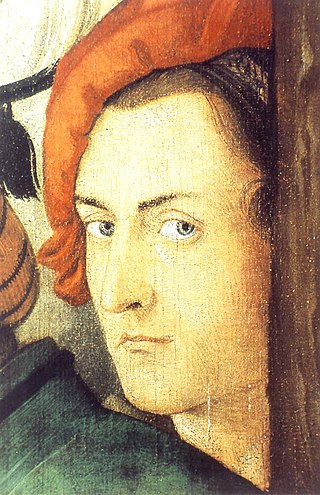
Hans Baldung, called Hans Baldung Grien,, was a painter, printer, engraver, draftsman, and stained glass artist, who was considered the most gifted student of Albrecht Dürer and whose art belongs to both German Renaissance and Mannerism.

Mannerism is a style in European art that emerged in the later years of the Italian High Renaissance around 1520, spreading by about 1530 and lasting until about the end of the 16th century in Italy, when the Baroque style largely replaced it. Northern Mannerism continued into the early 17th century.
Events from the year 1515 in art.

In art history, "Old Master" refers to any painter of skill who worked in Europe before about 1800, or a painting by such an artist. An "old master print" is an original print made by an artist in the same period. The term "old master drawing" is used in the same way.
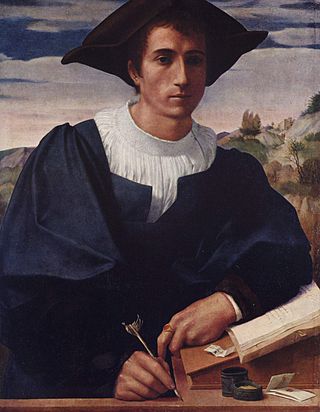
Franciabigio was an Italian painter of the Florentine Renaissance. His true name may have been Francesco di Cristofano; he is also referred to as either Marcantonio Franciabigio or Francia Bigio.

Sebastiano del Piombo was an Italian painter of the High Renaissance and early Mannerist periods famous as the only major artist of the period to combine the colouring of the Venetian school in which he was trained with the monumental forms of the Roman school. He belongs both to the painting school of his native city, Venice, where he made significant contributions before he left for Rome in 1511, and that of Rome, where he stayed for the rest of his life, and whose style he thoroughly adopted.

Vicente Juan Masip was a Spanish painter of the Renaissance period. He is commonly considered the foremost member of the Valencian school of painters.

The Self-Portrait with a Friend is a painting by Italian High Renaissance painter Raphael. It dates to 1518–1520, and is in the Louvre Museum of Paris, France. Whether the figure on the left is actually a self-portrait by Raphael is uncertain, although it was already identified as such in a 16th-century print.
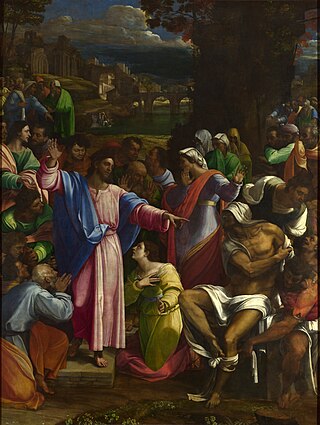
The Raising of Lazarus is a large altarpiece of 1517–1519 by the Italian High Renaissance artist Sebastiano del Piombo, for which Michelangelo supplied drawings for some figures. Intended for Narbonne Cathedral in France, it is now normally in Room 18 of the National Gallery in London, where it is "NG1", the first painting catalogued at the founding of the gallery in 1824.
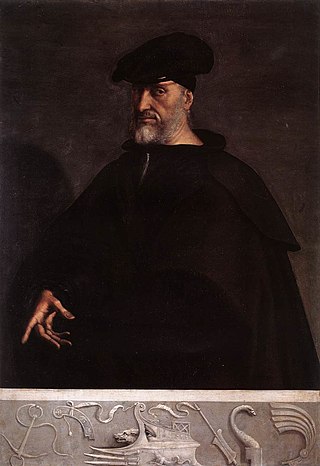
The Portrait of Andrea Doria is a painting finished c. 1526 by the Italian High Renaissance painter Sebastiano Del Piombo. It was painted after Sebastiano had fully mastered his Roman style. The painting depicts Andrea Doria, a famed naval commander from Genoa. Doria had rescued the city from French control and was made a prince as a reward. The naval symbols on the relief at the bottom of the painting emphasize Doria's rank of Admiral. The imitation antique relief at the bottom of the painting was likely included at the wishes of the patron.
Events from the year 1514 in art.
Events from the year 1518 in art.
Events from the year 1547 in art.
Events from the year 1529 in art.
The decade of the 1480s in art involved some significant events.

Giacomo Raibolini, also called Giacomo Francia or Jacopo Francia, was an Italian painter and engraver of the Renaissance period.
Events from the year 1523 in art.

Andrea del Sarto was an Italian painter from Florence, whose career flourished during the High Renaissance and early Mannerism. He was known as an outstanding fresco decorator, painter of altarpieces, portraitist, draughtsman, and colorist. Although highly regarded during his lifetime as an artist senza errori, his renown was eclipsed after his death by that of his contemporaries Leonardo da Vinci, Michelangelo, and Raphael.
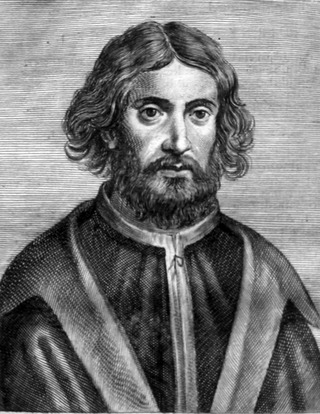
Palma Vecchio, born Jacopo Palma, also known as Jacopo Negretti, was a Venetian painter of the Italian High Renaissance. He is called Palma Vecchio in English and Palma il Vecchio in Italian to distinguish him from Palma il Giovane, his great-nephew, who was also a painter.













